|
|
|
|
|
ABIT IC7-MAX3 i875P Motherboard |
|
Join the community - in the OCAU Forums!
|
SecureIDE, Cooling
SECURE IDE
The IC7 Max 3 comes with “Secure IDE” as a bundled feature. The Max 3 can be used with or without it connected. The heart of Secure IDE is Enova’s “X-Wall” chip. This chip resides on a small daughter board that has to be installed between the HDD and one of the mainboard’s IDE PATA ports. X-Wall is encrypting and decrypting the entire hard disk including the boot sector and operating system, temp and swap files. Encryption/decryption operations occur in real-time. Enova is stating that the X-wall chip “performs all encryption and decryption operations while offering unprecedented throughput of 1.1Gbit/sec and zero performance degradation”. ABIT’s Secure IDE bundled with the Max 3 is using the 40-bit DES (Data Encryption Standard) version of the X-Wall chip. Enova is offering versions of this chip with up to 128-bit encryption.
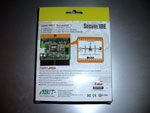 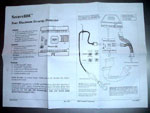
Authentication and access to system data is controlled using the X-Wall Secure Key. The Secure Key stores the encryption key used by the X-Wall chip to encrypt data. The correct Secure Key must be inserted into the key socket before booting to authenticate the user and authorize the operating system to load before granting access to data stored on the hard drive. Secure IDE is compatible with all operating systems and functions with all Ultra DMA (Ultra ATA) 33/66/100 compliant disk drives. It does not work with SATA disks. The Enova X-Wall chip providing hardware encryption for the harddisk is also available as stand alone PCI card. Guessing by the way “Secure IDE” is packaged we assume that ABIT will sell this device also separately in the same way as they are doing it with their Serillel PATA to SATA adaptors. When a user installs a hard drive with the Secure IDE on the IC7-MAX 3 motherboard, he is asked to enter the system BIOS and enable the lockdown through a FDISK format disk command. Through an associated software utility, the disk is formatted and can be only unlocked when the security dongle is used. All data on the harddisk are lost when Secure IDE is set up for the first time on this disk.
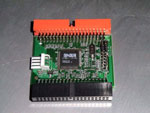 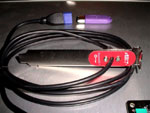 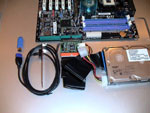
COOLING
ABIT is marketing the IC7 Max 3 as the mainboard with the “most advanced cooling technology ever seen before on a motherboard.” These are strong words but we think they hold true. First of all: the MCH/Northbridge HSF is substantially improved. Contrary to many other 875P boards like the ASUS P4C800-E and even Intel’s 875P reference design, the first IC7 generation had active cooling. This is a must for serious 875P overclocking because above 250 MHz the 875P MCH gets hot. It is of course possible to run an 875P chipset based board above a FSB frequency of 250 MHz without active cooling. We have done many times with our P4C800-E, but it’s definitely not recommended for a longer period of time when the air temperature is close or above 30C. However, the original IC7 heatsink, also used for the 865PE chipset based ABIT IS7, was rather small and ABIT has replaced it with a much bigger (and better looking) one on the Max 3. The 40 mm fan is running at around 4,500 rpm.
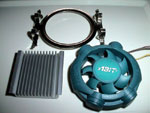 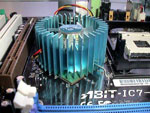 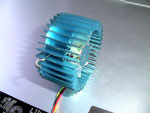
L to R above: old MCH fan from IC7, new MCH fan on MAX3, new fan side view
The more important cooling feature and a true innovation is the “Outside Thermal Exhaust System” or OTES implemented on the Max 3. OTES was originally developed by ABIT as cooling system for their high-end video cards. In fact, we first saw it in our review of their GF4 Ti4200 card. They have now modified it for use on their motherboards. OTES is serving 2 purposes: cooling down hot parts of the circuitry and transporting hot air out of the case. It comprises 3 parts: A transparent airduct, 4 heatsinks and springs, and a fan.
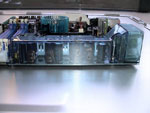 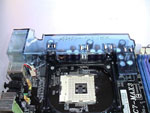 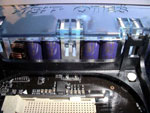
The airduct is not entirely closed. It has a 3 mm wide gap on one side that allows air from the surrounding PCB area socket to be sucked into it. The airduct has aluminum heatsinks integrated that are pressed by springs onto the 4 mosfets. The area above the heatsinks is also kept open to allow air to be sucked in. The warm air is then blown out of the OTES airduct (and the PC case) by a 40 mm fan at around 4,500 rpm at the end of the casing. This way an airstream is created, which flows over and around the hottest parts of the PCB circuitry: the power width modulation, the mosfets and the capacitors. We unscrewed the OTES airduct from the PCB and found the device well made by design and material. It must have taken ABIT engineering some time to design and test this device.
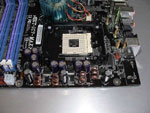 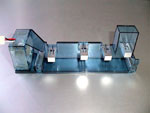
As an eye pleasing gimmick ABIT has placed 3 greenish LEDs inside of the transparent plastic housing. The OTES fan can be monitored by the BIOS and a Windows based monitoring utility. ABIT stays realistic in regard to the effect of OTES. They are not claiming that OTES ensures that a CPU could be overclocked higher. They are pointing out that by “better cooling, long-term electrostatic migration is reduced, resulting in longevity and better stability.”
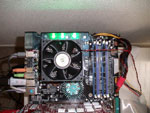 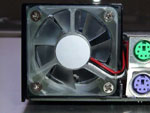
OTES is definitely working in terms of transporting hot air out of the case. The user can easily feel this by checking the airstream pushed out of the OTES airduct with his hand. ABIT’s own tests show that OTES is reducing mosfet temperature by 1/3, from around 90 Cº to 60 Cº.

(ABIT image)
|
|
Advertisement:
All original content copyright James Rolfe.
All rights reserved. No reproduction allowed without written permission.
Interested in advertising on OCAU? Contact us for info.
|

|


